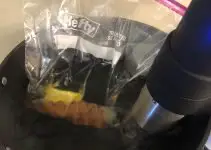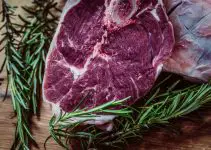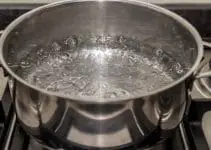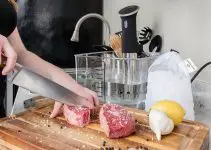Table of Contents
The term “sous vide” is a frequent sight on restaurant menus and internet discussions, but neither the term nor its use is new. Sous vide is a cooking technique that was first described in the 1800s, and later refined into the method that gets used today.
Sous vide translates to “under vacuum”, and the popular technique uses vacuum sealed food that gets subjected to boiling temperatures for a long enough time to ensure cooked, hot food.
Food that is described as sous vide must be vacuum sealed and heated under the right conditions – and for the right amount of time for what’s sealed in the bag. When it isn’t, then it can’t be called sous vide food.
There are a lot of benefits to the use of sous vide in both home and professional kitchens.
Making food sous vide isn’t just for convenience, but it can make the preparation of high-quality dishes faster when it matters. It also makes things less complicated when fast food preparation (but gourmet-quality dishes) intermingle in a kitchen.
But does sous vide make meat tender?
This is one of the most common questions that people have when it comes to sous vide.
Here’s what you should know about sous vide foods, and why many meat-eaters are learning to prefer it.
An Introduction to Sous Vide
First descriptions of sous vide date back to at least the 1800s, when someone first realized the benefit of cooking food under vacuum seal. Modern usage of sous vide can be traced back to several French chefs in the 1970s, who brought the technique into their own kitchens.
Sous vide – or “under vacuum” – gives the convenience of complicated dishes or hard-to-source ingredients made available in a perfect state. Contrary to popular beliefs, you can’t just boil food in a bag and call it a steak.
Thanks to the popularity of cooking shows and YouTube chefs, the sous vide method has become more widespread in the average home kitchen. Professional sous vide cookers are just an Amazon order away for most people.
For a complete history of the Sous Vide head here – History of Sous Vide Cooking
What Sous Vide is Not
Proper sous vide food is not just food that has been boiled in a bag. Ziplock’ed food isn’t proper sous vide either, but a lot of people have tried it this way and had mixed (often mixed up) results. If you want to try sous vide, a professional-style cooker is recommended – and proper sous vide food requires vacuum sealing for good reason.
How Sous Vide Works
For sous vide cooking to work, vacuum sealed food has to be brought up to high-temperatures, but that’s not all. It’s also important for the temperature to be kept there for as long necessary for the food to be cooked (and not just warm).
What can you do with sous vide?
Anything, and that’s what more home cooks and professional chefs are coming to see.
Sous vide can be employed to make some of the finest or fanciest dishes.
A large amount of chefs have also started to advocate the use of sous vide for steak. Steak can be difficult to prepare and get just right, but with sous vide, cooking time is easy to calculate – and it can have clear benefits for the food itself.
Sous Vide and… Steak?
There are a lot of people who say that you can’t make an excellent steak sous vide, but these are the same people who wouldn’t be able to tell the difference between an aged, marinated steak prepared in front of their eyes or a sous vide that tastes the same!
Sous vide is a popular way to prepare steak, not just for the convenience, but also for the effect it has on the meat.
Chefs often sear or seal their steak first before it goes in for vacuum sealing. When preparing a steak for customers, many still want the traditional flavorful outside of the steak you’ll see with cuts that have been done in a pan.
But what does sous vide do to meat, other than prepare it?
What Makes Meat Tough
A tough steak is every chef’s nightmare, and every restaurant patron’s worst day out. When you’ve paid for a steak, you want it to be of a certain quality – and a properly done steak from a professional should be melt-in-your-mouth, almost butter-like soft, never tough.
Always remember that steak is made up of muscle.
When meat is improperly cooked or “shocked”, meat cuts are often tough. Meat that has been overworked can also, sometimes, come out tough on the plate. Temperature, meat quality and cooking time all might have an effect.
When you don’t know what you’re doing, you can turn even the best steak cut into a tough, hard-to-eat piece of leather.
Does Sous Vide Make Meat Tender?
Most people can agree on what a good steak is (and isn’t). The best steak is perfectly tender, and contains all the locked-in flavors on the inside of the meat – no matter whether you like yours rare, medium or well-done.
Bad steak is tough, difficult to eat and makes the patron feel like they’re wrestling a live bull with their fork. When going to a restaurant or preparing steak at home, you don’t want to feel like your food puts up a fight.
Sous vide isn’t just easier, but can also help to make meat far more tender.
The science behind sous vide makes that steak, under pressure, gets infused with all the essential flavors deep into the meat. Sous vide can have a similar effect on food to using a pressure cooker, but won’t require as long for the same effect.
Sometimes, steak can become tough due to the sudden shock of a room-temperature steak hitting a heated up pan. The muscle contracts from the shock, and the once-great steak becomes tough as nails.
Because flavor is infused deep into the meat, sous vide is one of the best ways for ensuring a tender steak every time.






